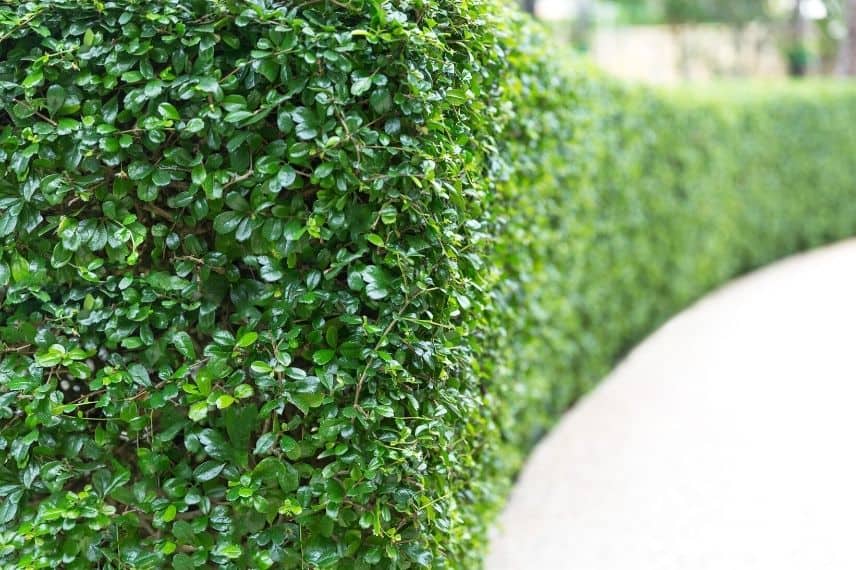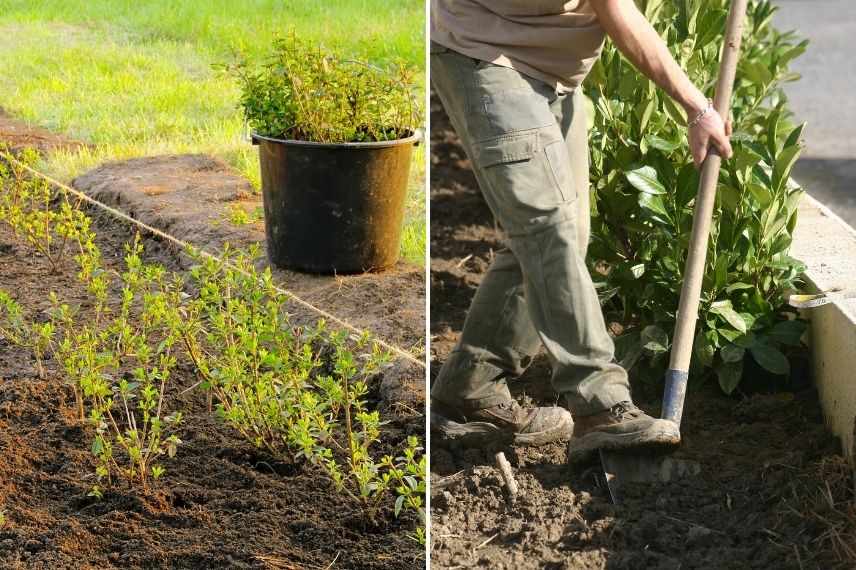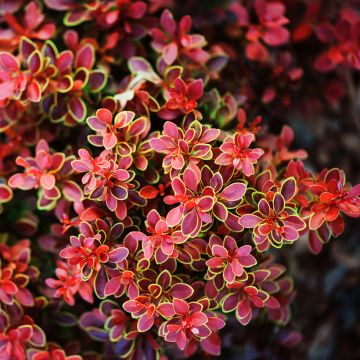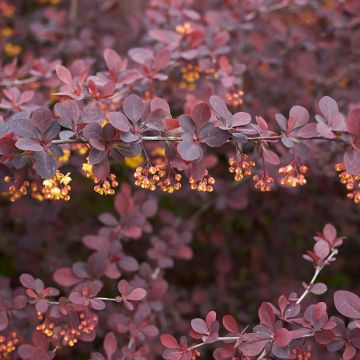
How to create a Berberis hedge?
our tips and techniques on when and how to plant
Contents
The Berberis is a beautiful bush with a dense habit, perfectly suited for planting as a specimen, at the edge, in borders, but also in a free or structured hedge. Its decorative foliage in purple, gold, or glossy green adds a splash of colour to the garden. Its flowering is followed by fruiting, producing small, colourful, ornamental berries. This thorny bush, sometimes referred to as Barberry, is also the ideal candidate for creating a defensive hedge. Discover our tips on when and how to create a Berberis hedge.

An example of a structured and pruned hedge
When to plant a hedge of Berberis?
Planting a hedge of Barberry is ideally done in autumn, from October to November, during the plants’ dormant period. Furthermore, the still warm soil at this time of year allows for good establishment of your young plants.
Deciduous Berberis can be planted as bare roots from October until the end of March, before the bud burst period of the leaves.
Container shrubs can be planted at any time of year, except during periods of drought, heavy rain, and frost. Once again, the autumn period remains the best choice for successful planting.
Read also
How to create a defensive hedge?Which variety of Berberis to choose?
Although Berberis is an easy plant to grow, choose varieties suited to the nature of your soil, whether it is chalky, poor, stony, dry, or heavy, compact, and wet.
Deciduous barberries are interesting for their beautiful purple foliage that will add colour to the garden. Meanwhile, evergreen Berberis primarily have glossy green leaves and offer abundant flowering. The latter are particularly used to form privacy hedges.
You can create a monochrome hedge by planting shrubs of the same variety or combine different cultivars to create a rich palette of colours. For a mixed hedge, plant 1/3 deciduous Berberis to 2/3 evergreen. This way, your hedge will never be completely bare during winter.
With their bushy and dense habit, Berberis require no special maintenance and are perfect for forming a free-standing hedge. On the other hand, they tolerate being pruned 1 to 2 times a year to create an orderly hedge. However, it is possible to limit maintenance by installing varieties of varying heights according to the desired hedge height.
For example, to form a low hedge, favour small shrubs, such as Berberis thunbergii ‘Inspiration’, which does not exceed 50 cm in height, or Berberis darwinii ‘Nana’ for its beautiful glossy evergreen foliage.
In a medium hedge, plant intermediate-sized shrubs, such as Berberis thunbergii, which reaches 1.5 m in height at maturity, or Berberis linearifolia ‘Orange King’ for its dark green glossy evergreen foliage and abundant flowering.
In a tall hedge, install large varieties, such as Berberis julianae, which can reach 3 m in height, or Berberis ottawensis ‘Superba’ for its beautiful deciduous purple leaves.
For successful establishment, favour younger shrubs that are not overly developed, measuring 30 to 40 cm in height.
→ Find all our Berberis varieties here

Berberis ottawensis ‘Superba’ and Berberis frikartii ‘Amstelveen’
Discover other Berberis - Barberries
View all →Available in 2 sizes
Available in 1 sizes
Available in 2 sizes
Available in 1 sizes
Available in 1 sizes
Available in 1 sizes
Available in 3 sizes
Available in 1 sizes
Available in 1 sizes
Available in 3 sizes
How to plant a Berberis hedge?
The necessary equipment:
- Thick gloves, goggles, and long clothing to protect against thorns.
- A spade, fork, pickaxe, shovel, bio-fork or any other tool to loosen, aerate, and dig the soil.
- A pruning shear
- Some Berberis
- A large bucket
- Some compost or well-matured manure
- A watering can
- If the bushes are bare-rooted: some cow dung, manure or ready-to-use pralin
- Optional: a string line for a straight hedge
Planting distance:
- For a hedge less than 1 m high: you can space your Berberis 50 cm apart.
- For a medium-sized hedge: plant your bushes every 60 to 80 cm.
- For a tall hedge: the planting distance is 1 m between each plant.
Also, be sure to respect the legal distance between your hedge and your neighbour’s property. If your hedge will be less than 2 m high, it should be placed 50 cm from the boundary of your garden. If your hedge exceeds 2 m in height, it must be planted more than 2 m from the boundary. Legislation can sometimes vary by municipality, so don’t hesitate to check with your local council.
Before planting: prepare your ground
- Mark the location of your hedge if you want a straight line. Use a string line or place a stake at each end of the hedge’s location, then stretch a twine to connect them. You just need to plant along your line.
- Prepare your soil: well-loosened, aerated, and weeded soil will ensure better establishment for your bushes. If your soil is too heavy, mix it with sand for gardens to facilitate water drainage and avoid root rot.
- Enrich the soil: adding compost or well-matured manure helps your plants establish better.
 Mark the location of your hedge with a string line and loosen your soil for successful planting
Mark the location of your hedge with a string line and loosen your soil for successful planting
Prepare your bare-rooted bushes:
- Planting or heeling in should be done as soon as they arrive.
- With a pruning shear, remove any damaged roots.
- Praline your roots: in a bucket, mix 1/3 soil with 1/3 compost or well-matured manure and 1/3 water. Dip the roots in the mixture so they are well coated. Let them soak like this until the next day.
Prepare your potted bushes:
- Soak the root ball of your Berberis by immersing it in a bucket of water for 1 hour.
- Gently untangle and loosen the root ball.
- Remove any damaged roots with pruning shears.
The steps for planting Berberis:
- Dig a trench twice as wide as the root ball.
- If your soil is heavy and clayey: add a 10 cm layer of gravel or sand at the bottom of the trench.
- Place your Berberis in the trench while respecting the spacing between plants.
- Replace the soil around the root ball and lightly compact.
- If you wish to densify your Berberis further, you can cut back the branches by 1/4 of their height.
- Water generously.
- Spread a layer of mulch at the base to retain moisture while insulating the roots from cold or heat. This will also help avoid weeding in a prickly environment.
- Water regularly during the first 2 years, especially during prolonged dry spells and heatwaves.
 Example of planting a staggered hedge
Example of planting a staggered hedge
For further reading
- Discover all our varieties of Barberries
- Check out our article to learn everything about barberries: planting, pruning, and maintaining
- Subscribe!
- Contents










































Comments